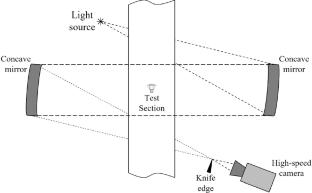Design and flow characterization of the Mach 5 shock tunnel at New Mexico State University
Abstract
This paper provides a comprehensive discussion on the flow characterization and design of the Mach 5 shock tunnel facility at the Hypersonic Research Center of New Mexico State University (NMSU). It reviews the operational principles of low-enthalpy shock tunnels as well as the measurement techniques employed for the facility characterization. The material and thickness of the secondary diaphragm are shown to significantly affect the stability of stagnation properties. Stagnation conditions are determined through an analysis of pressure–time history data measured in the driven tube. Schlieren flow visualizations over a 10\(^\circ \) half-angle straight cone and a sphere are used to estimate the freestream Mach number. Additionally, femtosecond laser electronic excitation tagging (FLEET) velocimetry is conducted to measure instantaneous velocities in the freestream and turbulent boundary layer flows within the test section. The shock tunnel has a total temperature ranging between 610 and 630 K, with a freestream Mach number of 5.1. The steady test time, as indicated by pitot pressure measurements, ranges from 2 to 2.5 ms, while velocimetry and wall-static pressure data suggest that driver gas arrival in the test section occurs approximately 30 ms after flow stabilization. The facility was made available for use in undergraduate courses in Fall 2022.


 求助内容:
求助内容: 应助结果提醒方式:
应助结果提醒方式:


